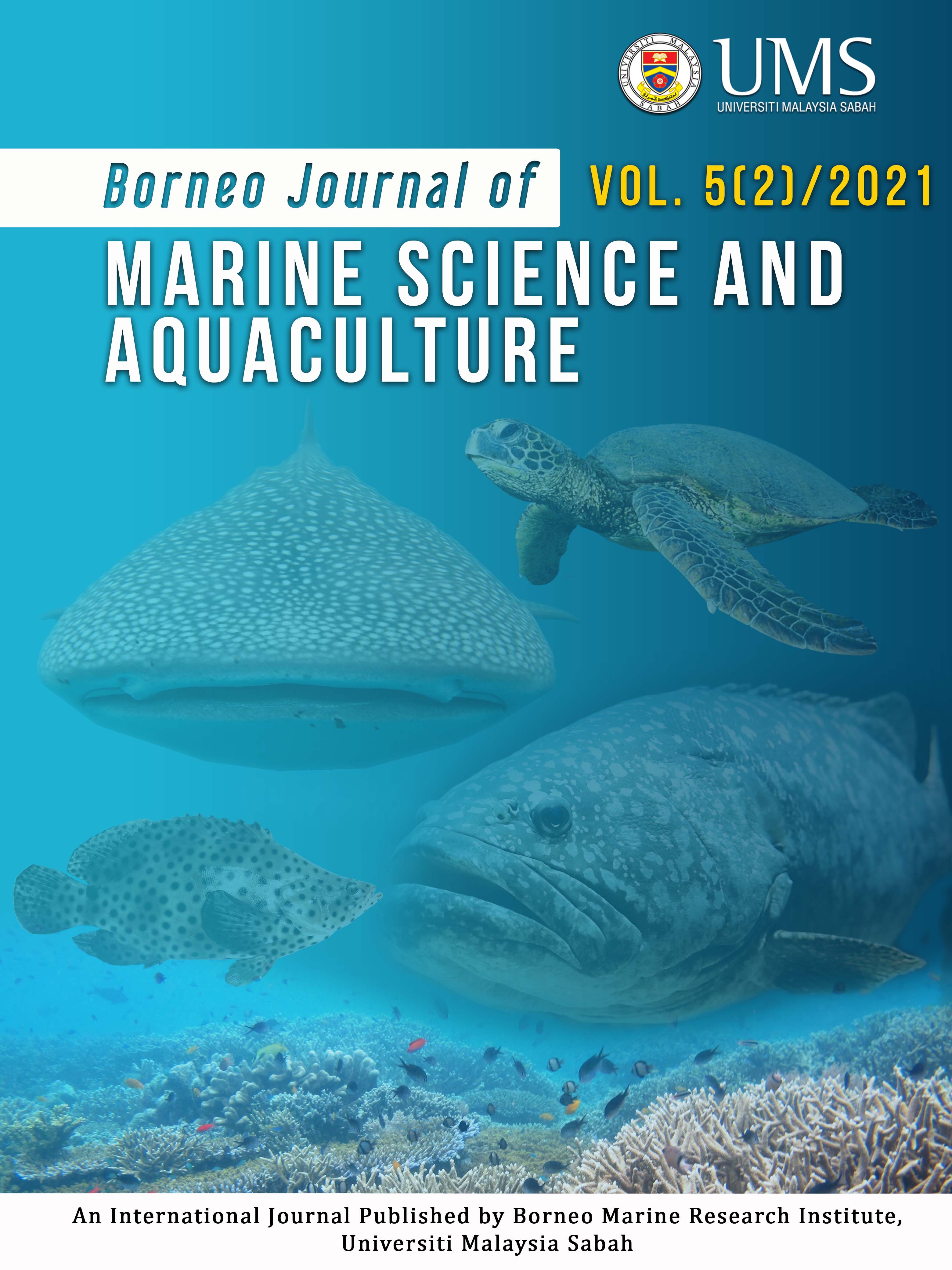Growth of Gracilaria manilaensis Yamamoto et Trono (Rhodophyta) under different light intensities, salinities and pH
DOI:
https://doi.org/10.51200/bjomsa.v5i2.2884Keywords:
Mariculture, Gracilaria, Rhodophyta, Seaweed, Growth rateAbstract
Previous studies have demonstrated that the seaweed, Gracilaria manilaensis, has a high potential of producing agar for the food industry, and is a promising candidate as a dietary supplement for treating cancer and neurological disorders. Unfortunately, not many farms culturing G. manilaensis existed particularly in Malaysia. One of the reasons is limited knowledge of suitable environmental conditions needed for efficient production of the seaweed. Therefore, this study was carried out to identify the best growth conditions for G. manilaensis under different light intensities, salinities and pH. To achieve this objective, Gracilaria sp. was collected from a farm and identified based on morphological characteristics before being subjected to three environmental variables simultaneously: light intensities (100 and 1000 lux), salinities (15, 20, 25 and 30 psu) and pH (7.6, 7.8 and 8.0) simultaneously. Specific growth rates were determined for all the treatments. The results showed that G. manilaensis preferred high light intensity (1000 lux), with the growth rate of 1.69 ± 0.08 g/days at the salinity of 15 psu and pH 7.6. No significant differences were found between salinity and growth rate, indicating that G. manilaensis can tolerate a wide range of salinity. The knowledge gained from this study can be used as a guide to increasing the production of G. manilaensis in indoor farming systems. This will ensure sustainable research for G. manilaensis and production.
References
Abdullah, NS., Muhamad, S., Omar, IC. et al. (2013). Determination of antioxidant and cytotoxic activities of red seaweed (Gracilaria manilaensis) against different cancer cell lines. Journal of Food Science and Engineering 3, 616-624.
Agrawal, SC. (2012). Factors controlling induction of reproduction in algae-review: the text. Folia Microbiology 57, 387-407. DOI : https://doi.org/10.1007/s12223-012-0147-0
Ahmad, T., Surif, M., Ramli, N. et al. (2011). A preliminary study on the agar content and agar gel strength of Gracilaria manilaensis using different agar extraction processes. World Applied Science Journal 15, 184-188.
Bunsom, C. & Prathep, A. (2012). Effects of salinity, light intensity and sediment on growth, pigments, agar production and reproduction in Gracilaria tenuistipitata from Songkhla Lagoon in Thailand. Phycological Research 60, 169-178. DOI : https://doi.org/10.1111/j.1440-1835.2012.00648.x
Buschmann, AH., Camus, C., Infante, J.et al. (2017). Seaweed production: overview of the global state of exploitation, farming and emerging research activity. European Journal of Phycology 52, 391–406. DOI : http://doi.org/10.1080/09670262.2017.1365175
Carton, RJ., Caipang, CMA., Notoya M. et al. (2011). Physiological response of two seaweeds biofilter candidates, Gracilariopsis bailiniae Zhang et Xia and Hydropunita edulis (S Gmelin) to nutrient source and environmental factors. Aquaculture, Aquarium, Conservation & Legislation International Journal of the Bioflux Society 5, 635-643.
Cirik, S., Cetin, Z., IIknur, S. et al. (2010). Greenhouse cultivation of Gracilaria verrucosa (Hudson) Papenfuss and determination of chemical composition. Turkish Journal of Fisheries and Aquatic Science 10, 559-564. DOI : https://doi.org/10.4194/trjfas.2010.0417
Cornish, ML. & Garbary, DJ. (2010). Antioxidants from macroalgae: potential application in human health and nutrition. Algae 25, 155-171. DOI: https://doi.org/10.4490/algae.2010.25.4.155
De Almeida, CLF., Souza, MDFV., De Barbosa-Filho et al. (2011). Bioactivities from marine algae of the genus Gracilaria. International Journal Molecular Science 12, 4550–4573. DOI: https://doi.org/10.3390/ijms12074550
Dhargalkar, VK, & Pereira, N. (2005). Seaweed: promising plant of the millennium. Science Culture 71, 60-66.
Dillehay, TD., Ramırez, C., Pino, M. et al. (2008). Monte Verde: seaweed, food, medicine, and the peopling of South America. Science 320, 784–786. DOI : https://doi.org/10.1126/science.1156533
Gioele, C., Marilena, S., Valbona, A. et al. (2017). Gracilaria gracilis, source of agar: a short review. Current Organic Chemistry 21, 380–386. DOI: http://doi.org/10.2174/1385272820666161017164
Hebbale, D., Chandran, MDS., Joshi, NV et al. (2017). Energy and food security from Macroalgae. Journal of Biodiversity 8, 1-11. DOI : https://doi.org/10.1080/09766901.2017.1351511
Kim, JK, Yarish, C., Hwang, EK. et al. (2017). Seaweed aquaculture : cultivation technologies, challenges and its ecosystem services. Algae 32, 1–13. DOI : https://doi.org/10.4490/algae.2017.32.3.3
Lobban, CS. & Harrison, PJ. (1994). Seaweed Ecology and Physiology. Cambridge University Press, New York. DOI : https://doi.org/10.1017/CBO9780511626210
McHugh, DJ. (2003). A guide to seaweed industry. FAO Fisheries Technical Paper.Food and Agriculture Organization of the United Nations.
Nagappan, T. & Vairappan, CS. (2014). Nutritional and bioactive properties of three edible species of green algae, genus Caulerpa (Caulerpaceae). Journal of Applied Phycology 26, 1019-1027. DOI : https://doi.org/10.1007/s10811-013-0147-8
Nayar, S. & Bott, K. (2015). Current Status of Global Cultivated Seaweed Production and Markets. World Aquaculture 45, 32–37.
Nor-Salamah. M., Mohammad-Noor, N., Susanti, D. et al. (2015). The effects of different pH and salinities on growth rate and carrageenan yield of Gracilaria manilaensis. Jurnal Teknologi 77, 1-5. DOI : https://doi.org/10.11113/jt.v77.6728
Pang, JR., Veronica, MJ. G., Tan, CY. et al. (2018). Neuritogenic and in vitro antioxidant activities of Malaysiam Gracilaria manilaensis Yamamoto & Trono. Journal of Applied Phycology 30, 3253-3260. DOI : https://doi.org/10.1007/s10811-018-1438-x
Phooprong, S., Ogawa, H. & Hayashizak, H. (2007). Photosynthetic and respiratory responses of Gracilaria vermiculophylla (Ohmi) Papenfuss collected from Kumamoto, Shizuoka and Iwate, Japan. Nineteenth International Seaweed Symposium Development in Applied Phycology 2, 293- 300. DOI : https://doi.org/10.1007/978-1-4020-9619-8_37
Raikar, SV., Lima, M., & Fujita, Y. (2001). Effect of temperature, salinity and light intensityon growth of Gracilaria spp. (Gracilariales, Rhodophyta) from Japan, Malaysia and India. Indian Journal of Marine Science 30, 98-104.
Singh, SP. & Singh, P. (2013). Effect of temperature and light on the growth of algae species. A review. Renewable and Sustainable Energy Reviews 50, 431-444. DOI : https://doi.org/10.1016/j.rser.2015.05.024
Skriptsova, AV. & Nabivailo, YV. (2009). Comparison of three gracilarioids: growth rate, agar content and quality. Journal of Applied Phycology 21, 443-450. DOI : https://doi.org/10.1007/s10811-008-9389-2
Yamamoto, H. & Trono, GC. (1994). Two new species of Gracilaria from the Philippines. In: Taxonomy of Economic Seaweeds (Norris, ed.), pp 95-102. California Sea Grant College, La Jolla.
Yu, CH., Lim, PE., & Phang, S.M. (2013). Effect of irradiance and salinity on the growth of carpospores-derived tetrasporophytes of Gracilaria edulis and Gracilaria tenuistipitata var liui (Rhodophyta). Journal of Applied Phycology. 25:787-794. DOI : https://doi.org/10.1007/s10811-012-9960-8






